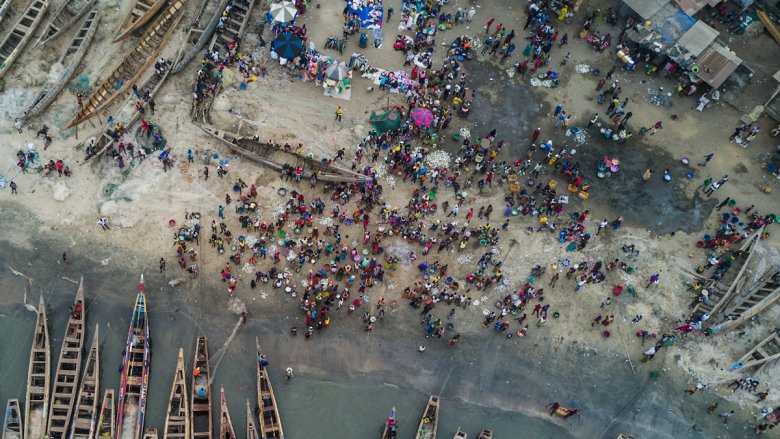Solutions in Action
The Blue Economy will play a major role in Africa��s climate adaptation. The growth of Africa��s Blue Economy requires focused and decisive action on four cross-cutting areas: institutional development and governance; spatial planning; data management and knowledge creation and dissemination; and financing. The long-term sustainable development benefits of a resilient Blue Economy will be substantial, not least of which for the people whose jobs and livelihoods depend on healthy ocean ecosystems.
Participatory marine spatial planning
Across Africa, as elsewhere in the world, governments face the complicated challenge of needing to make policy decisions about highly contested marine and coastal resources in the absence of a well-established body of knowledge. Marine spatial planning is a tool for managing coastal and marine ecosystems that defuses this challenge while meeting climate change resilience goals. By including a broad range of stakeholders in participatory mapping and decision-making processes, marine spatial planning reduces investment risk and improves investor confidence. This is important because Africa��s Blue Economy will require substantial private sector investment.
Various African countries have, with the World Bank��s support, used marine spatial planning to develop management frameworks for their blue resources, with some going on to declare new marine protected areas to serve as breeding grounds to replenish declining fisheries, among other ecological benefits. Find out more in (PDF).
Cutting-edge data management and knowledge creation
Decision-makers from all sectors need to be able to access to credible, current data on the state of Africa��s oceans and coasts if they are to put in place programs, policies, and institutions that will create and support a thriving Blue Economy. Historical lack of investment into data collection, research and analysis, and technology has resulted in a dearth of usable, accessible data, coupled with poor institutional capacity. With sufficient investment into the building of systems and capacity, the continent could ��leapfrog�� into a new milieu in which the latest technologies are used to gather, process, and disseminate data and knowledge about Africa��s marine and coastal systems, so supporting decision-making that will strengthen the continent��s Blue Economy.
This leap is already happening. With the World Bank��s support, Guinea has produced an online visualization tool that maps coastal land cover changes over time, Tanzania has used drone footage to assess the extent of its coastal plastic pollution problem, and a regional coastal observatory for West Africa has been developed, to name just a few examples. Find out more in (PDF).
Innovative financing instruments
Coastal African countries will need access to a range of financing options if they are to realize the immense potential of their blue economies. Depending on their local context, they may need, grant financing, debt relief linked to environmental outcomes, or equity financing��as just three possible examples. The private sector is an important part of the solution. Optimizing the timing and focus of public and development finance and partnerships to ensure a catalytic effect offers new opportunities.
ľ��ӰԺ has a portfolio of more than US$7 billion of ongoing investments in oceanic and ocean-related sectors worldwide. Its holistic approach to helping countries mobilize capital includes providing technical advisory to help with the development of integrated ��ridge to reef�� projects, which will better be able to address the multiple crises that Africa��s oceans face��chief among them climate change��while developing a robust Blue Economy. Capital financing takes various forms, with recent innovations focusing on blue bonds, carbon credits, parametric insurance, and debt-for-climate swaps. Find out more in (PDF).
Institutional development, governance, and coordination
Activities to develop sustainable and resilient ocean economies can be hamstrung by fragmented policies, unrealistic budgets, and limited cooperation across blue sectors. To address these challenges, the World Bank works with various African countries and regions to foster coordinated, capacitated, and realistic approaches to managing the Africa��s coastline and oceans. Success combines development opportunities with nature-based solutions to arrive at well-capacitated institutions with collaborative governance structures that draw on the best available science to balance conflicting goals and use incentives to trigger transformation. Find out more in (PDF).
Jobs and livelihoods
Africa��s working-age population is expected to grow to 450 million people by 2035. The continent��s Blue Economy has potential to create jobs and secure livelihoods for this generation of Africans in a way that empowers them to contribute to decision-making and the sustainable governance of marine and coastal resources. To achieve this goal, critical governance and policy reforms are needed to better align economic interests with long-term sustainability while promoting conditions that encourage business growth in a sustainable seafood sector. Public-sector capacity will also need to be built. Measuring the success of reforms on jobs and livelihoods can be challenging, but when the restoration of mangroves, seagrass beds, and dune vegetation, for example, combine with successful climate-smart job and livelihood support in Africa, the cutting edge of Blue Economy thinking reveals itself. Find out more in (PDF).
Click on the cover image to download each brief (in PDF).
